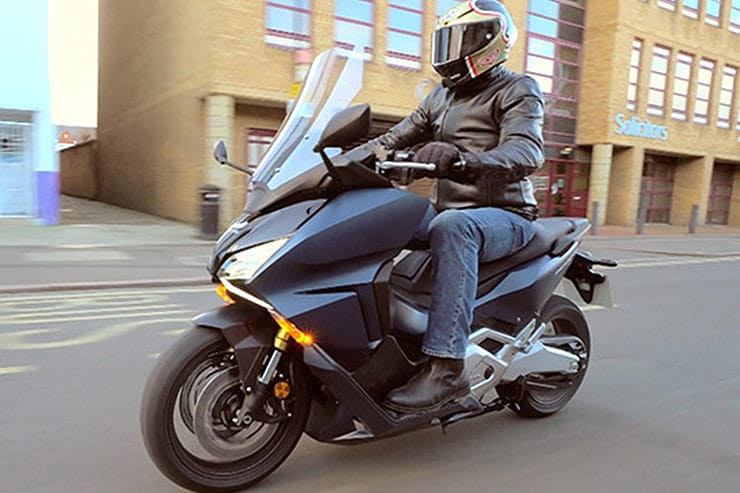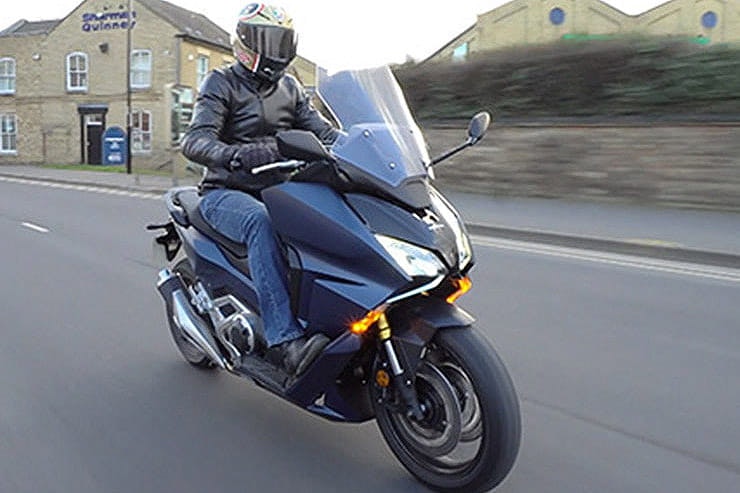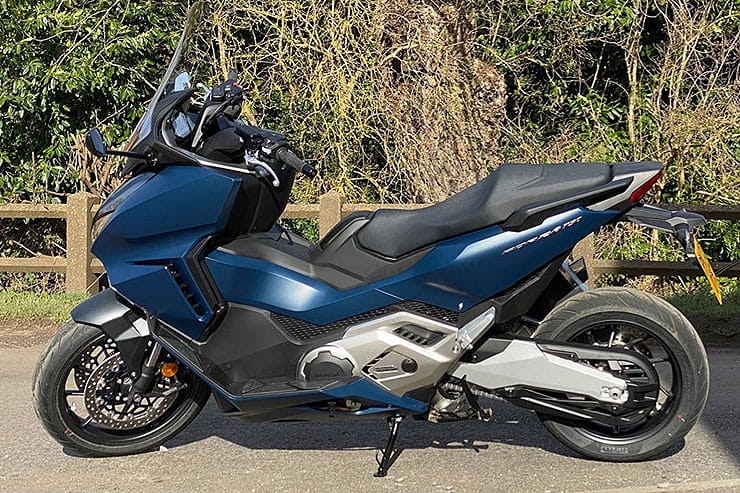Honda Forza 750 (2021) - Review
By Michael Mann
BikeSocial Managing Editor
09.04.2021
Helmet
AGV Pista GP-R (with bespoke paint by LDC Designs) - Price: £999.99 (for the new RR)
There are maxi scooters on the market such Yamaha’s XMAX 300 or BMW’s C400X, designed with practicality as their strong suit; bike-like performance, handling and range with scooter-style ease of use and storage space. Then there’s this; a ‘mega scooter’, according to its builder. The Honda Forza 750 is the latest addition to the more premium and blingy Forza range that’s been around since 2015 with a 125cc and a 300cc offering, although for 2021 the 125 has been updated, the 300 has been replaced by a 350, while the 750 is a new. Potter around the trendy coastal towns and villages of the French and Italian Riviera’s and you’ll see swathes of them being ridden by attractive folk in flip-flops and sunglasses, though sun-soaked jaunts aren’t the Forza’s only strength. We test its capabilities as a town/city-based commuter as well as banging in some bigger miles on the dual carriageway in Britain’s winter.
Sturdy and quick twist n’ go
Instant power and slick DCT technology
Smart TFT screen
Non-adjustable screen
No cruise control
Despite its practicality, it’s very wide (think getting it in and out of your garage or parking spaces)
On the road with the 2021 Honda Forza 750
BikeSocial’s Michael Mann takes Honda’s new ‘megascooter’ for a spin around town, on the dual carriageways and with a pillion
Honda Forza 750 Price
How much is the 2021 Honda Forza 750? £9999.
While dropping 10-grand on a twist ‘n go may on paper seem a little teeth-sucky, the spec sheet, level of practicality and rival prices would suggest otherwise.
There are four colour options available depending how your levels of flamboyancy for the Peterborough Riviera – Candy Chromosphere Red, Matt Beta Silver Metallic, Jeans Blue Metallic or Graphite Black. And the Forza 750 is in dealerships right now.
If you’d rather stretch those payments over three years with a PCP deal then via Honda you can put a deposit of £1973.84 down then 36 monthly payments of £129 with a final payment of £4,702.27 for and annual 4,000-mile contract.
Power and Torque
Headline figures for twist and go scooters aren’t usually the power and torque ones, you tend to focus on economy, comfort and luggage space but because the Forza 750 comes with a hefty motor based on a version that’s been tried and tested in other Honda models you can sneak a glance and think about embarrassing some sportier types off the line. Peak power is hearty 57.8bhp (43.1kW) @ 6750rpm while the low-revving twin reaches its peak torque of 50.9 lbft (69Nm) @ 4750rpm. The bike scoot has economy, low speed acceleration coupled with higher speed cruising in mind rather than outrageous performance.
There’s an A2 restriction kit dropping engine output to 47bhp (35 kW) @6000rpm and 48 lbft (65Nm) @4000rpm.
Engine, Gearbox and Exhaust
The big scooter-cum-motorbike uses the same 745cc parallel twin that can also be found in the NC 750X and X-ADV and therefore it too is fitted with the latest generation of the Japanese firm’s Dual-Clutch Transmission (DCT). A manual gearbox that changes automatically with a range of settings to determine where in the rev range the upshift occurs. This big heart of the bike sits low and wide to offer optimum weight balance but the compromise is the width of the standover.
Naturally for a new bike in 2021 it comes as Euro 5 friendly and with the Forza 750’s commuter-derived gearing and performance, it’s all about those first few yards away from a standing start and to accelerate out of trouble or traffic. With a shudder and a low-level grumble, the initial surge is followed by a gradual roll-on feeling languid, lazy and little forced but the twin-cylindered engine springs into life with more assertiveness when directly proportional to a big handful of throttle input – those 58 horses have been trained well to perform away from the line at the traffic light GP.
Three rider modes (Rain, Standard and Sport) with pre-set parameters plus a bespoke User mode for your own settings allow you to amend the level of Engine Braking, Power, Traction Control and the responsiveness of where in the rev range the DCT ‘box changes in Auto mode. It can be overridden too with the + and – buttons on the left switchgear. It all sounds quite complicated but is easy to get used to. Rain and Standard modes are, for me, just for show. The power is smothered and the DCT gearbox changes up too quickly for my liking though the offset of decreasing performance will increase the economy if that’s your bag.
I spent the majority of my 200-miles in Sport mode which isn’t as aggressive as it might sound and that’s underlined by the note from the upswept exhaust whose sound changes from an already unique twin-esque grumble to, between 6-7k rpm, a cross between a MotoGP bike and a flymo… a high-pitched and more assertive whisp if you will. The red line is at 7k which is where it’ll change up if you’ve got the throttle wide open.
The chain-drive won’t be to everybody’s liking but concerns over durability and weather protection can be eradicated thanks to the cover making it virtually surrounded. Plus the standard fit centre stand offers easy lube application for the chain.
Honda Forza 750 Comfort and Economy
The large and low seat measures 790mm and is good for comfort levels for the shorter journey. Even with a neat and supportive lower back rest between rider and pillion in the one-piece seat, and while it may not look like it from a side-profile, I felt tilted forwards whether my feet were flat down on the running boards or stretched out. Speaking of which, when in the reclined and more cruiser-like position, the foot plates are tall enough for my size 11’s but definitely not wide enough at the top which is noticeable when in the non-Mediterranean coastal temperature of 3-degrees on the dual carrigeway. Despite my winter-spec Dainese boots and double sock layer, my tootsies weren’t so toasty. And the same goes for my hands. Again, a Gore-Tex set of Dainese semi-winter gloves weren’t good enough for some mid-March chills and while heated grips aren’t a requirement for the majority of maxi scooter owners on the continent, these Mann hands were crying out for a set for the A14. They’re available as an accessory at around £300.
To alleviate some lower back discomfort, I took the option of sliding my feet into the flat position making them parallel with the ground which is wide enough and offers a little more weather protection. Because of the size of the engine and gearbox, your feet and legs are splayed out a little more than a more traditional bike and when it comes to stopping at the lights, attempting to flat foot has to be more purposeful than it’d normally be. If you’re thinking about buying a big Forza then make sure you’re ok with balancing that 235kg weight at low or no speed during your test ride.
The big screen is clear and redirects the breeze well. It’s tall and its angle would suggest it’d move the rain away quickly. But, it’s not adjustable which is a shame because riders of varying heights may not agree with my conclusion about its wind deflection. The lights are excellent too offering a brilliant spread for your night time rides. Rear view mirrors are oddly placed on long stems which are adjustable but I can’t see why they wouldn’t be any closer to the rider to make them easier to reach.
From the Forza’s 13.2 litre tank, Honda claim an economy figure of 78.5mpg which is all well and good except that after brimming the tank and trotting off for a 140-mile trip on A-roads (not the 160 I mention in the video) and dual carriageways with predictable throttle use, the fuel gauge had just begun to flash as I reached my destination. With a generous assumption, there’d still be 20 miles left in the tank, that’s 160-miles and an economy resembling the indicated 57.3mpg.
Above: with the optional top box
Handling, Suspension and Weight
The Honda’s performance is easy, the notion of twisting and going is accentuated by the relative power of the 750 compared to that of a 125 version, and while the handling might be devoted to town, it can still hustle on the grown-up roads with hedges on either side. The low centre of gravity and larger-than-normal front wheel adds a degree of mischief. The 15” rear tyre is expected on a scooter but it’s accompanied by a 17” front which look a peculiar match but the larger front adds sturdiness and it doesn’t seem to affect slower speed handling too much either. Pirelli’s specific scooter tyres worked a charm around the B-roads while offering plenty of comfort and lack of vibration over and around the pot holes, drain covers and enthusiastically painted bus stop signs in the road. They complimented the commendable 41mm Showa upside down forks nicely too.
Physically it’s a big vehicle in length and width which lessens the convenience of a scooter when parking, performing low speed manoeuvres or shuffling through tight traffic or a side gate to your house. But it’s sturdy with (from what I can tell) excellent build quality which looks like it’ll last many winters and it has smart bodywork lines from front to back which make the Forza stand out as a premium machine.
At 235kg ready to roll, it’s no lightweight either meaning waddling into or out of a busy motorcycle parking bay is going to be tricky if you’re not familiar with balancing the weight and width.
Honda Forza 750 Brakes
Four-piston radial Nissin brake calipers and even an additional handbrake (because you can’t put a DCT-equipped machine in gear if you park on a hill though it has quite a curious operation in that you have to bend the lever through 180-degrees to activate) are welcome and nicely specced additions. Just like a bicycle or smaller scooter, the rear brake is operated via the left-hand lever though I found it a bystander because Sport mode offers that added level of engine braking and the front bite while not super strong on the initial bite still did its job well.
Rider aids and Pillion Comfort
A very handy, small keyless fob, known as a Smart Key, can be tucked away neatly in your jacket because it a key isn’t required for the ignition, seat or fuel cap though keep it in your jacket because even when riding on one occasion the warning light appeared on the screen telling me the fob wasn’t within range.
The fuel cap cover is released by pressing one of the two small buttons in front of the ignition button/wheel though the cap itself is a bit fiddly to unscrew with winter gloves on… then where do you put it when filling up? The cubby pocket built into the right side of the front fairing is an obvious choice but that’s pitched on a downwards angle making it tricky to reach whatever’s at the back if you don’t have child-sized hands.
The other button is to release the seat which tips forwards on a hinge to reveal its 22-litre storage area - spot on for a bit of shopping, your man/hand bag or a commuter style open-faced lid but not a peaky adventure style one nor my AGV Pista GP either. It does however come with a USB-c socket.
A clutch-style mechanism acts as an improved hoodlum-deterring steering lock which is an added bonus as this style of bike is a beacon for thieves.
Unfortunately, the windscreen isn’t adjustable nor does the bike comes with cruise control or heated grips (though these are an official accessory). There is a new Honda Smartphone Voice Control system; yay. But it’s not compatible with Apple products, yet; boo. While I’m pointing out some of my less favourite parts, I think the that while the 5” TFT display is top drawer with its operation, appearance and clarity, the left-side switchgear is less good. It won’t be too long before it feels dated and is a little cumbersome.
For a pillion opinion, I enlisted the help of my colleague, John Milbank, who is familiar with this part of a road test but it’s usually his wife on the back. It’s got some height and looks wide and a comfy place to be with the seat height and peg position looking like they’re placed to offer the pillion plenty of room but he’s 5’10” (178cm) and approaching 50 years old with hips that don’t lie. Well, they ache a bit on a proper sportsbike and he felt similar on the Forza 750 – he felt scrunched up. He’d have wanted a top box because the bike has plenty of go and that might have relieved some of the hip-ache too. The grab rails are big and easily accessible too.
Rivals
I’ve opted for four scooter-style competitors even though there are plenty of sub 10 grand motorbikes offer similar performance and practicality once a top box is included, for example.
Honda Forza 750 (2021) Verdict
For £10k there’s a lot of Scoot-cycle for the money but it is still a lot of money. The Forza 750 is easy to ride, convenient to hop on and then off you zoom. It has presence, practicality, charisma, creature comforts and a hearty amount of oomph to win that all-important traffic light grand prix or get you out of mischief on the motorway.
There are a few niggles though; lack of weather protection, heated grips and an adjustable screen. The seat is pitched forwards and not massively comfortable on a longer journey plus the footplates are too narrow. Then there’s the almost/nearly bits; where do you put that fuel cap? Why isn’t the glove box wide enough for my perfectly normal sized adult hand especially when it’s angled down?
Electronically, the modes are well-worth exploring especially the bespoke section customisable just for you, whereas this newest spec DCT gearbox works a treat in this environment. The Forza 750 is a stylish, aggressive-looker too who’d be just at home on the coastal roads in the South of France as on the city streets.
While initially I had no intention of needing a maxi scooter, I’m now trying to convince myself that I don’t need one! Though for my purposes, perhaps the 350 will do what I need it to given its comparative dimensions, weight and price.
Honda Forza 750 (2021) Technical Specification
Photography by Dom Read-Jones / Motion Films
What is MCIA Secured?
MCIA Secured gives bike buyers the chance to see just how much work a manufacturer has put into making their new investment as resistant to theft as possible.
As we all know, the more security you use, the less chance there is of your bike being stolen. In fact, based on research by Bennetts, using a disc lock makes your machine three times less likely to be stolen, while heavy duty kit can make it less likely to be stolen than a car. For reviews of the best security products, click here.
MCIA Secured gives motorcycles a rating out of five stars, based on the following being fitted to a new bike as standard:
A steering lock that meets the UNECE 62 standard
An ignition immobiliser system
A vehicle marking system
An alarm system
A vehicle tracking system with subscription
The higher the star rating, the better the security, so always ask your dealer what rating your bike has, and compare it to other machines on your shortlist.


